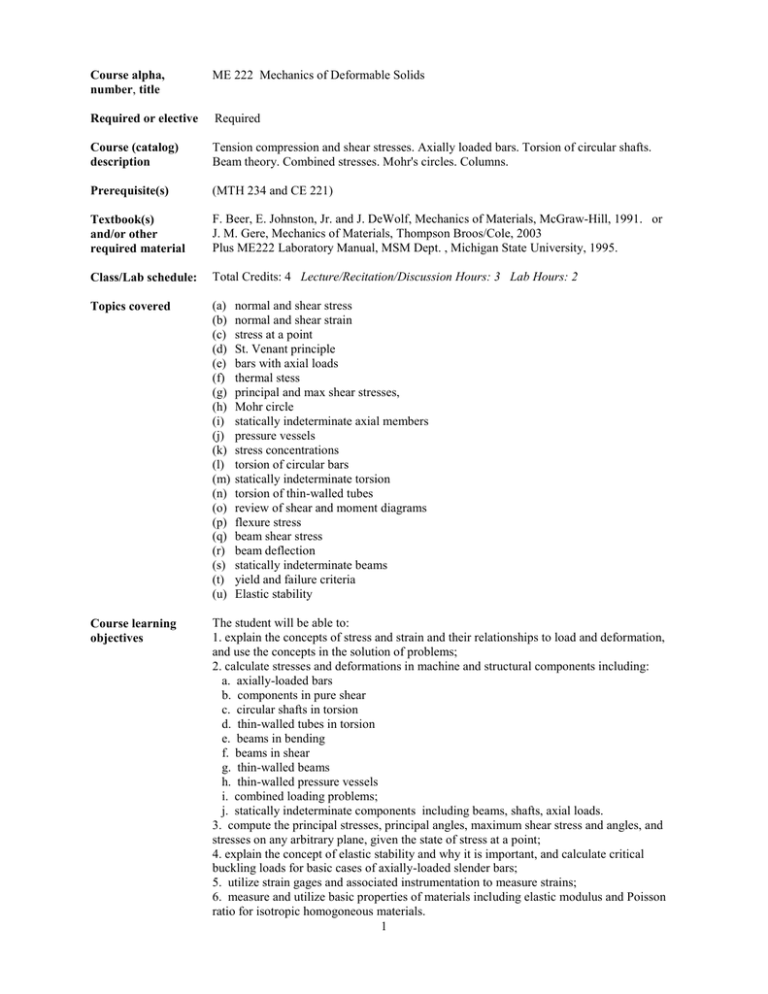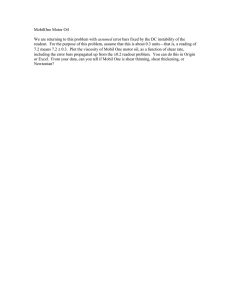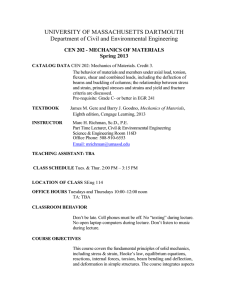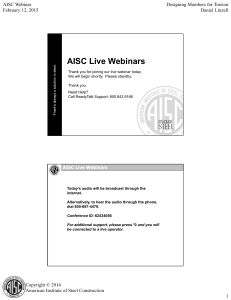ME 222 Outline.doc
advertisement

Course alpha, number, title ME 222 Mechanics of Deformable Solids Required or elective Required Course (catalog) description Tension compression and shear stresses. Axially loaded bars. Torsion of circular shafts. Beam theory. Combined stresses. Mohr's circles. Columns. Prerequisite(s) (MTH 234 and CE 221) Textbook(s) and/or other required material F. Beer, E. Johnston, Jr. and J. DeWolf, Mechanics of Materials, McGraw-Hill, 1991. or J. M. Gere, Mechanics of Materials, Thompson Broos/Cole, 2003 Plus ME222 Laboratory Manual, MSM Dept. , Michigan State University, 1995. Class/Lab schedule: Total Credits: 4 Lecture/Recitation/Discussion Hours: 3 Lab Hours: 2 Topics covered (a) (b) (c) (d) (e) (f) (g) (h) (i) (j) (k) (l) (m) (n) (o) (p) (q) (r) (s) (t) (u) Course learning objectives The student will be able to: 1. explain the concepts of stress and strain and their relationships to load and deformation, and use the concepts in the solution of problems; 2. calculate stresses and deformations in machine and structural components including: a. axially-loaded bars b. components in pure shear c. circular shafts in torsion d. thin-walled tubes in torsion e. beams in bending f. beams in shear g. thin-walled beams h. thin-walled pressure vessels i. combined loading problems; j. statically indeterminate components including beams, shafts, axial loads. 3. compute the principal stresses, principal angles, maximum shear stress and angles, and stresses on any arbitrary plane, given the state of stress at a point; 4. explain the concept of elastic stability and why it is important, and calculate critical buckling loads for basic cases of axially-loaded slender bars; 5. utilize strain gages and associated instrumentation to measure strains; 6. measure and utilize basic properties of materials including elastic modulus and Poisson ratio for isotropic homogoneous materials. 1 normal and shear stress normal and shear strain stress at a point St. Venant principle bars with axial loads thermal stess principal and max shear stresses, Mohr circle statically indeterminate axial members pressure vessels stress concentrations torsion of circular bars statically indeterminate torsion torsion of thin-walled tubes review of shear and moment diagrams flexure stress beam shear stress beam deflection statically indeterminate beams yield and failure criteria Elastic stability Relationship of course to ME program outcomes The following measurement standard is used to evaluate the relationship between the course outcomes and the educational-program outcomes: 3 = Strong Emphasis, 2 = Some Emphasis, 1 = Little or No Emphasis. (a) an ability to apply knowledge of mathematics, science, and engineering—3 (b) an ability to design and conduct experiments, as well as to analyze and interpret data—3 (c) an ability to design a system, component, or process to meet desired needs—2 (d) an ability to function on multi-disciplinary teams—2 (e) an ability to identify, formulate, and solve engineering problems—3 (f) an understanding of professional and ethical responsibility—2 (g) an ability to communicate effectively—3 (h) the broad education necessary to understand the impact of engineering solutions in a global/societal context—1 (i) a recognition of the need for and the ability to engage in life-long learning—1 (j) a knowledge of contemporary issues—2 (k) an ability to use the techniques, skills, and modern engineering tools necessary for engineering practice—2 (l) design, build, and test in mechanical systems area—1 (m) design, build, and test in thermal/fluids area—1 (n) application of advanced mathematics—2 (o) capstone design experience—1 Contribution to professional component: 100% Engineering Science 0% Engineering Design Person(s) who prepared this description Farhang Pourboghrat and Patrick Kwon Date of Preparation 4/7/04 2
![Applied Strength of Materials [Opens in New Window]](http://s3.studylib.net/store/data/009007576_1-1087675879e3bc9d4b7f82c1627d321d-300x300.png)




